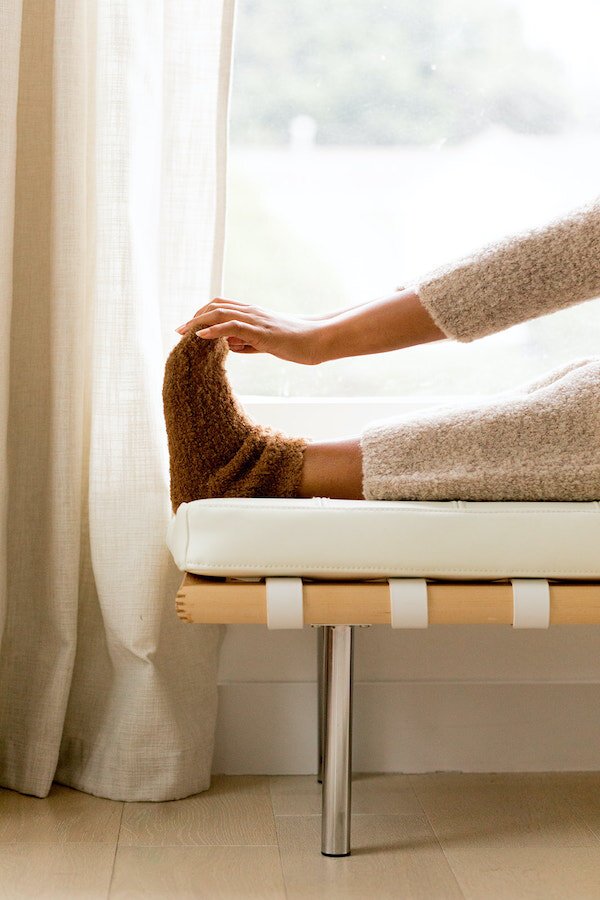
The Benefits Of A Quick Nighttime Stretching Routine
Plus, Four Soothing Stretches to Try
Every instructor of movement emphasizes the importance of stretching, from those in our elementary school gym classes, to the ones leading the barre sessions we take as adults. We gently pull and press and bend ourselves before and after any activity to avoid injury. And less intentionally—when we wake or have been sitting too long—our bodies instinctively reach, lengthen, and twist.
“When we wake or have been sitting too long… our bodies instinctively reach, lengthen, and twist.”
And yet, for years, I skipped the guided cool-downs after working out, even if I wasn’t pressed for time. It wasn’t until I unexpectedly learned from a doctor that I had a mild case of scoliosis that I felt the urge to make movement a priority. How long I’d had scoliosis, why it’d gone unchecked for so long remained unknown; but what was encouraged as treatment, among other things, was daily stretching.
I’m not a morning person, so instead I searched YouTube for evening movement practices and came upon what has since become one of my most revisited clips: a bedtime yoga session filmed on a Nicaragua beach, the instructor surrounded by candles and trees. Now, I recreate the mood in my own space—well, as best I can. I turn off my offensively bright overheard light, drape a flimsy red scarf over my desk lamp (safely!), play nature noises or a sound bath found on Spotify, and move. Slowly.
Stretching at night feels complementary to me. The unhurried movements mimic the sun’s slow set. And as the day comes to a close, so does my body. There are no errands to run afterward, no tasks left to complete but sleep. It’s the perfect time.
“Stretching at night feels complementary to me. The unhurried movements mimic the sun’s slow set.”
Regardless of the hour, however, experts agree that it’s essential.
“Gentle and slow stretching shifts the nervous system from fight-or-flight mode into rest-and-digest mode, which causes the heart rate to slow down,” says registered yoga teacher Clara Roberts-Oss, founder of Practice With Clara. She adds that stretching can also increase the blood flow and circulation to our muscles and brain which helps “recover and repair tissues,” as well as release feel-good hormones—dopamine, serotonin, and norepinephrine—for a calming effect on the mind. “The perception of pain lessens, allowing the body to enter a state of relaxation,” says Roberts-Oss.
Pointing to a 2016 Journal of Cellular Physiology study, Tiffany Cruikshank, L.AC, MAOM, founder of Yoga Medicine, adds that passive, held poses can also have anti-inflammatory effects as they target the Ruffini endings, a type of sensory nerve; the effect being a decrease in sympathetic nervous system activity—otherwise known as the stress response. Ultimately, she says, “Stretching at night can be a great way to down-regulate the nervous system.”
And how we breathe as we stretch can do our body good, too. By breathing deeply, Roberts-Oss says we slow the activity of the vagus nerve that connects to our organs, including the brain, heart, lungs, and stomach. “Stretching the body goes hand-in-hand with the breath,” she says. “And when we move slowly, we’re more likely to pay attention to how we breathe and to breathe more deeply.”
As we connect our breath and our bodies, we become more mindful, too. Everyday distractions can often keep us from checking in with ourselves in real time and acting accordingly based on our needs. According to Daniela de Silva, founder of Blue House Yoga, stretching can bring us back to the present moment and can help us recover from the common stresses we endure during the day.
“As we connect our breath and our bodies, we become more mindful, too.”
And if, like me, you’re inclined to nighttime routines, de Silva explains that incorporating a stretching ritual before bed can especially help us return to our bodies and release the accumulation of stress in our fascia and muscles. This will ultimately improve our sleep quality which, de Silva reminds, is strongly tied to our overall health. “A restful night of sleep is one of the strongest pillars for sports performance, wellbeing, and cognition,” she says.
Tara Stiles, global yoga expert and author of “Clean Mind, Clean Body” echoes the sentiment on the importance of sleep. “It’s really helpful to have a simple practice that transitions you from taking in information, thinking and doing things, to coming back to yourself at night,” she says.
According to Stiles, not being able to “power down” is directly linked to not getting good rest. “If your mind is racing, your body is tense and it can be impossible to relax. A simple routine of getting down on the ground, slowing down, connecting with your breath, and moving how it feels good can go a long way.”
If you’re ready to start stretching, here are four stretches you can try tonight.
A Simple Bedtime Stretching Routine
When I stretch for my spinal health, I opt for movements that align or create space between my vertebrae. I reach from side to side and return to center, making sure to proudly elongate myself. I lay down on my mattress or the floor and lift and lower my hips, imagining I can feel each interlocking bone curl away from and return to my mat. I gently twist my upper body, glancing over each of my shoulders before slowly swiveling back. But I also love to practice poses I once did daily as a dancer in high school to see how accessible they still are. (It’s humbling.) Do what feels good to you. And keep in mind, much like self-massaging, the pressure shouldn’t result in pain.
Happy Baby Recommended by Daniela de Silva
Lie in bed flat on your back. Bend your knees toward your chest at a 90-degree angle (soles of your feet should be toward the ceiling). Grab the inside or outside of your feet with your hands. Bring your knees toward your armpits at the same time that you bring the soles of your feet a little higher. Remain in this position for several breaths, inhaling and exhaling deeply.
Lying Down Twist + Knee Hug Recommended by Tara Stiles
Lay on your back on the ground. Hug your knees into your chest gently and hang there for a few long, deep breaths. With arms relaxed and extended out to the sides, let your legs fall over to one side. Breathe. Let your legs fall to for the other side. Breathe. Bring your legs back to your center and give yourself a hug.
Forward Fold Recommended by Tiffany Cruikshank
Begin in a standing position, hips aligned over your ankles. With knees slightly bent, slowly lean forward at the hips, lengthening your torso as you descend, and let the crown of your head hang. It it feels better to do so, spread the legs bit wider. Try rounding the spine to target a larger area of tissue along the back. And support yourself with your hands, yoga blocks, or other household items so you can stay there and relax the tissues.
Cat/Cow Undulations Recommended by Clara Roberts-Oss
Position yourself on your hands and knees (hips-width apart), with hands directly under your shoulders and knees directly under your hips. Keep your head in a neutral position. Inhale as you drop your belly towards the ground, lifting your chin and chest. Exhale as you round your back and draw your belly toward your spine, releasing the crown of your head toward the floor. Repeat.
Do you stretch regularly? How has it benefitted your body and mind? Share in the comments!
RELATED READING
Danielle Cheesman was born and raised in New Jersey, where she lived until moving to Philadelphia to study journalism at Temple University. She has spent her years writing and developing editorial visions for music, art, and lifestyle brands. Now residing in Los Angeles, you can usually find her taking pictures, making playlists, or cuddling her pup. Say hi on Instagram!
